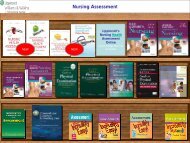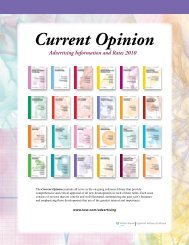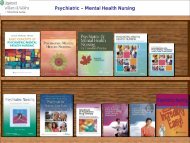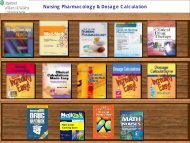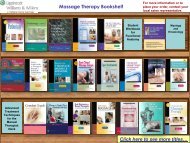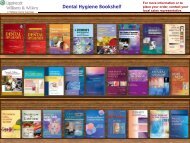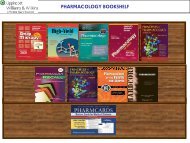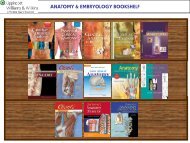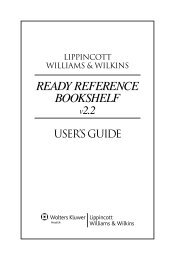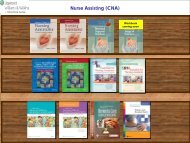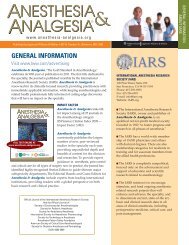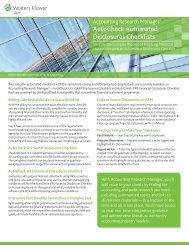Communication Disorders Bookshelf
Communication Disorders Bookshelf
Communication Disorders Bookshelf
- No tags were found...
Create successful ePaper yourself
Turn your PDF publications into a flip-book with our unique Google optimized e-Paper software.
<strong>Communication</strong> <strong>Disorders</strong> <strong>Bookshelf</strong>For more information or toplace your order, contact yourlocal sales representative.
Speech Science Primer: Physiology,Acoustics and Perception of Speech,Sixth EditionLawrence J. Raphael PhDGloria J. Borden PhDKatherine S. Harris PhDFebruary 2011/ 416pps/ 40illus/ 978-1-60831-357-0Instructor Resources:•PowerPoint•Chapter Outlines•Test Bank (NEW)Student Resources:•Audio Clips of speechsamples•Student Study Questions(NEW) Chapter Outlines•PowerPointFeatures:• NEW! Updated art program, including 10 new figures andupdating 30 existing figures• Material on speech respiration and expanded informationon cross-language speech issues• Information on acoustics, speech physiology, and speechperception is integrated to create a unified treatment ofspeech science• An explanation of the normal communication processserves as a basis for comparison with communicationdisorders• Audio clips available on the companion Website arereferenced in the text by an icon• A bibliography concludes each chapter to encouragefurther study
Clinical Management of Articulatoryand Phonologic <strong>Disorders</strong>, Third EditionMary Gordon-Brennan PhDCurtis Weiss PhD2006/ 400 pp./ 100 illus./978-0-7817-2951-2Features:•Primary textbook for introductory courses in articulationand phonological disorders•Focuses on articulation and phonological developmentand disorders, their management, and the manyapproaches/techniques of current treatment•Chapter subheadings that lead students throughout thematerial•Boxed questions about important information•Case examples to illustrate practical applications; chaptercontent summaries and study suggestions for instructors;and 100 illustrations•Chapters on treatment feature quick reference protocolsof various treatments for students to use in planningintervention for case study projects, observations ofclinicians, or their own clients
Stuttering: An Integrated Approach toIts Nature and Treatment, Third EditionBarry Guitar2005/ 480 pp./ 65 illus./978-0-7817-3920-7Instructor Resources:•Essay and Multiple ChoiceQuestions and Answers•PowerPoint SlidesStudent Resources:•Essay and Multiple ChoiceQuestionsFeatures:•Multi-disciplinary approach includes insights fromdevelopmental psychology, genetics, neurology, and cognitivescience•Explains the different levels of stuttering severity, and the bestmanagement strategies for each•Provides different perspectives on the treatment of stutteringfrom experienced clinicians and covers the broad spectrum of"schools of thought" on clinical approaches•Two part structure, "Nature of Stuttering" and "Assessment andTreatment of Stuttering“•Information about children at risk allows quick identification ofchildren who should be referred for evaluation•Pedagogical features include chapter outlines, special boxes,tables and displays, study questions, and suggested readings•New Chapter 13 "Related Fluency <strong>Disorders</strong>"•New Chapter 6, "Preliminaries to Assessment"•Expanded information on differential diagnosis of stutteringversus other fluency disorders and supplemented by a chart•Appendices contain forms on diagnosis and evaluation, aswell as useful websites and addresses for programs, books, andorganizations
Treatment of Stuttering: Established andEmerging InterventionsBarry Guitar, PhD, CCC-SLPRebecca McCauley, PhD, CCC-SLPOctober 2009/ 464 pp./ 53 illus./ 978-0-7817-7104-7Instructor Resources:•PowerPoint Slides•Test Generator•Image BankStudent Resources:•Treatment Videos•Answers to ChapterReview QuestionsFeatures:•Continual Reference to Evidence-Based Practice•Key Terms are listed in the beginning of each chapter forquick reference•Chapter Outline, at the beginning of each chapter, sets asolid foundation for the information that follows•Chapter Summary, at the end of each chapter, synthesizesand reinforces the information presented in the chapter•Suggested Readings, at the end of each chapter, guidestudents to additional information•Chapter Review Questions quiz students on coveredmaterial and reinforce key points in the reading. Answers areavailable on thePoint.•Case Studies bring concepts to life and enhance criticalthinking skills
Neuroscience for the Study ofCommunicative <strong>Disorders</strong>, Third EditionSubhash C. Bhatnagar PhDInstructor Resources:•Bonus Student Review questionsand answers•Answers to textbook Quiz•PowerPoint Slides•Image Bank•Blackboard/WebCT cartridgesStudent Resources:•Bonus Student Review questions•Animations•Appendices•Labeling Exercises•Video2007/ 498 pp./ 205 illus./978-0-7817-8990-5Features:•Neuroimaging section now includes the latest techniquesin magnetic resonance-based diagnostic imaging•Significant updates to discussions of cellular biology,neuroembryology, and consciousness•Structures and neuronal pathways are now illustrated•50 additional interactive case studies ask readers to applytheir knowledge of neuroscience concepts to assist patientswith communicative disorders•More than 400 new terms and definitions have beenadded to the glossary•Over 70 new and revised figures help readers visualize allthe key concepts and neurological functions presented inthe text•Summary tables provide at-a-glance overviews of keytopics•End-of-chapter quizzes gauge the reader's understandingof the material before advancing in the text•BONUS: Purchasers of this book will have access to acompanion Website with resources including animations,video clips, review questions, labeling exercises, and more
Neuroscience: Exploring the BrainMark F. Bear PhDBarry W. Connors PhDMichael A. Paradiso PhD2006/ 928 pp./ 657 illus./978-0-7817-6003-4Instructor Resources:•Lecture outlines•Student activities and assignments•Image Bank•PowerPoint•Test Generator•Path of Discovery Boxes•WebCT/Blackboard Cartridges•LiveAdviseStudent Ancillaries:•Animations•Video Clips from Acland•Drop and Drag Labeling Exercise•Answers to review questions•Quiz Bank•Glossary of Key Terms•SmarthinkingFeatures:•Increased coverage of taste and smell, circadian rhythms, braindevelopment, and developmental disorders•Increased emphasis on molecular mechanisms to keep pace withrecent discoveries•Increased coverage of functional brain imaging, reflecting rapidadvances in understanding the human brain and cognition•24 Path of Discovery boxes highlight current discoveries andachievements of key individuals in the field of neuroscience•Separate chapters on Language (Ch. 20) and Attention (Ch. 21)•Appropriate writing style and level for undergraduates beginningtheir study of neuroscience•Brain Food boxes highlight advanced material, allowing forflexibility in the classroom•An Illustrated Guide to Human Neuroanatomy (an appendix tochapter 7) includes a perforated self-testing workbook•Brain and Behavior chapters:−Chapter 16: Motivation, includes coverage of the fat gene−Chapter 17: Sex and the Brain−Chapter 21: Mental Illness•Review questions at the end of each chapter•Of Special Interest boxes highlight relationships betweenneuroscience and real life
Neuroscience for Rehabilitation,Second EditionHelen Cohen EdD, OTR, FAOTA1998/ 544 pp./ 184 illus./978-0-397-55465-2Features:•Updated material on neural mechanisms of learning•New chapter on aging in the nervous system•More gross anatomy•Updated material on the neuron:−Neurotransmitters, Chapter 4−Somatic Senses, Chapters 6 to 8−Special Senses, Chapters 9 to 12−Motor Control, Chapters 13 to 15•Chapters are written by noted scientific experts withclinical backgrounds so material is practical as well asevidence based•The relationship of the material to clinical practice isexplained at the end of each chapter•Detailed glossary provides a quick reference for thereader•Detailed reference lists at the end of each chapter--amust for this science oriented course
Hearing ScienceDana Emanuel PhD, CC-ATomasz Letowski PhD, ScDJanuary 2008/ 352 pp./ 208 illus./978-0-7817-8047-6Instructor Resources:•Video demonstrations•PowerPoint slides•A test generator•An image bank•Homework assignmentswith answersFeatures:•Objectives provide students with a quick overview ofcontent to be covered•Key Terms are bolded within the text to help students focuson and retain crucial topics•Example Problems show students how to work throughproblems related to each major concept•Practice Problems provoke thought and test student'scomprehension of each chapter's major concepts•A Summary and a list of Key Points provide a brief recap ofimportant information discussed in each chapter•Links, called out in the text with an icon, are includedonline to provide help in understanding basic concepts, toprovide more information on a topic, or to help studentswork through the text's practice problems step by step
Hearing in Children, Fifth EditionJerry L. Northern PhD2001/ 450 pp./ 170 illus./978-0-683-30764-1Features:•Practical descriptions of age-specific pediatric testingtechniques, including step-by-step protocols•Emphasis on medical aspects of pediatric hearing loss -genetics, syndromes, diseases and disorders, etc.•Appendix of hearing disorders - an alphabetized,encyclopedic presentation of ninety syndromes andcommon disorders associated with childhood deafness•Thorough discussions of the various schools of thought inmanagement of children with hearing loss
Audiology: The Fundamentals, FourthEditionFred H. Bess PhDLarry E. Humes PhDInstructor Resources:•Tables•Image Bank•Online Quizzes•Vignette Images•Syllabus ConversionGuideStudent Resources:•Online Quizzes•Weblinks2008/ 400 pp./ 170 illus./978-0-7817-6643-2Features:•New two-color design plus some fifty new anatomicaldrawings and figures help students better visualize anatomyand understand key concepts and procedures•Advanced material, previously inserted as supplements atthe end of the chapter, has been integrated into the bodyof each chapter•Additional vignettes have been added to enhance theunderstanding of key concepts and include some specificexperiments that can be used in the classroom•Easy to read format, moving from basic information tomore complex subject areas, that parallels the format ofmost introductory courses•Learning Objectives provide guidelines regarding materialthat will be discussed in each chapter.•Chapter Summaries provide a brief recap of importantinformation discussed in each chapter
Audiology and <strong>Communication</strong><strong>Disorders</strong>: An OverviewLarry E. Humes PhDFred H. Bess PhDInstructor Resources:•Test Generator•Case Studies with Q&A•Image Bank•Student resources•PowerPoint SlidesStudent Resources:•Quiz Bank•Case Studies and questions•Animations•Audiograms and Tympanograms•Video Clips•Labeling Exercises•A&P image bank•Audio GlossaryOctober 2008/ 368 pp./ 100 illus./978-0-7817-7555-7Features:•Learning Objectives provide guidelines for each chapter•Key Terms are highlighted and defined within the chapter•Review questions•Five types of vignettes-Experiments, Conceptual Demos,Further Discussions, Clinical Applications, and HistoricalNotes-give better understanding of key concepts inAudiology as well as the challenges faced by the hearingimpaired•Experiment box illustrates a concept through anexperiment or learning activity•Conceptual Demo box uses a real-world example•Further Discussion box provides more commentary onconcepts mentioned or briefly discussed•Clinical Applications box discusses current/new tests,procedures, applications, or trends of concepts in a clinicalsetting•Historical Note box highlights the history of a person,equipment, or a concept and their/its effect on Audiology
Handbook of Clinical Audiology, SixthEditionJack Katz, PhDLarry Medwetsky, PhDRobert Burkard, PhDLinda Hood, PhDJanuary 2009/ 1031 pp./ 580 illus./978-0-7817-8106-0Features:•This Sixth Edition is divided into four sections:−Introduction, Basic Tests, and Principles−Physiology Principles and Measurements−Special Populations−Management of Hearing <strong>Disorders</strong>•Edited by noted professor of communication disorders•More than 70 contributors with research data and clinicalobservations•Coverage of special populations and problem management•Comprehensive references, including websites•New chapter on, “Building a Successful Audiologic Practice,”shows students how to combine audiologic skills andknowledge with core business skills•Clear, reader-friendly writing that stimulates thought, provokesdiscussion• Case Studies reinforce important concepts
Auditory Evoked Potentials: BasicPrinciples and Clinical ApplicationRobert F. Burkard PhDManuel Don PhDJos Eggermont PhD2006/ 736 pp./ 400 illus./978-0-7817-5756-0Features:•A chapter of laboratory exercises offers hands-onexperiences that transform the academic lessons of thedidactic chapters into laboratory and clinicalcompetencies•Case studies chapter illuminates the complexities ofclinical decision making.•Eight-page, full-color insert includes 3D images that arisefrom multi-channel evoked potential studies and functionalimaging modalities•Myth/Reality boxes shed light on misunderstood andsometimes contentious issues•Chapters on myogenic, somatosensory, visual, andvestibular evoked potentials provide the basic informationneeded for the clinical electrophysiologist•Key terms introduce the vocabulary needed tounderstand the central concepts of each chapter•Executive summary concludes each chapter with a reviewof main points to remember
Understanding Voice Problems: APhysiological Perspective for Diagnosisand Treatment, Fourth EditionRaymond H. Colton PhDJanina K. Casper PhD, CCC-SLPRebecca Leonard PhDJanuary 2011/ 512 pp./ 166 illus./ 978-1-60913-874-5Student Resources onthePoint•Video•Image BankInstructor Resourceson thePoint•Video•Image BankFeatures:• Insightful case studies included in the diagnostic chaptershelp your students apply what they have learned andbuild critical thinking skills• 29 videos (7 new) demonstrating healthy, normallyfunctioning larynges at work, plus larynges with variouspathological problems.• New critical thinking chapter questions facilitate discussionand application of key concepts• New key terms identified at the beginning of each chapterand highlighted and defined within the chapter• Numerous illustrations, including full-color plates of vocalfold pathologies.
Language Intervention Strategies inAphasia and Related Neurogenic<strong>Communication</strong> <strong>Disorders</strong>, Fifth EditionRoberta Chapey, EdDApril 2008/ 1091 pp./ 115 illus./978-0-7817-6981-5Features:•Most comprehensive text on aphasia assessment andtherapy•Contributors are 60 distinguished experts in the field•Coverage of team treatment and group therapy•Extensive appendices covering supplementary material•Important section on psychosocial approaches to dealingwith family issues•Activities for students encourages discussion•Coverage of approaches for bilingual and biculturalclients, and clients who need augmentativecommunication and computer assisted intervention•Coverage of neurological foundation of languagedisorders•Review questions encourage students to reflect uponwhat was just read
Terminology of <strong>Communication</strong><strong>Disorders</strong>: Speech-Language-Hearing,Fifth EditionLucille Nicolosi MAElizabeth Harryman MAJanet Kresheck PhD2003/ 408 pp./ 85 illus./978-0-7817-4196-5Features:•Leading dictionary/sourcebook of terms for speech,language, and hearing pathology•Written for students, faculty, and practitioners in speech,language, and hearing disorders programs•Terms listed alphabetically and cross-referenced forsynonyms and related terms•Accommodates the sometimes complex classifications ofSpeech, Language, and Hearing disorders
Stedman’s Medical Dictionary for theHealth Professions and Nursing,Seventh EditionStedman’s2011/ 2512 pp./ 1000 illus./ 978-1-60831-692-2Ancillary Assets:• More than 40,000pronunciations online• 5,600 illustrationsavailable onlineFeatures:• Over 56,000 terms• Nearly 65 valuable appendices• 1,000 illustrations• Anatomical insert by Anatomical Chart Company• Written pronunciations for every term• British alternative spellings• Precision-cut thumb tabs• A to Z organization for easier look up• Over 46 leading consultants from the fastest growingnursing and health professions contributed to theenhancements of this latest edition• FREE One year subscription to Stedman’s Online• FREE version of Stedman’s PLUS Medical/PharmaceuticalSpellchecker ($99 value)
Textbook of Head and Neck Anatomy,Fourth EditionJames L. Hiatt, PhDLeslie P. Gartner, PhDApril 2009/ 400 pp./ 310 illus./ 978-0-7817-8932-5Instructor Resources:•Image Bank•PowerPoint Slides•Full-Text OnlinStudent Resources:•Quiz Bank with over 200questions•Full-Text OnlineFeatures:•Colorful designs with new photographs, drawings andtables•Coverage on tooth development, eruption, andprimary/secondary dentition (Chapter 4)•Mini-atlas with new color plates from Rohen’s Color Atlasof Anatomy•Clinical consideration boxes address the clinicalimportance of information presented•Discussion of anatomic basis of anesthesia and lymphaticdrainage•An embryological account of head and neckdevelopment•Highlighted anatomic terms•Index includes additional cross-referencing to givestudents easy access to the desired listing
Applied Anatomy and Physiology forSpeech-Language Pathology and AudiologyDonald Fuller, PhDBarbara M. Peregoy, MA, CCC-AJanuary 2011/ 672 pp./ 235 illus./ 978-0-7817-8837-3Instructor Resources:•Test Bank•Answers to Part Questionsthat are within thetextbook•Image BankStudent Resources:•Interactive Student QuizBank•Animations on theworkings of anatomicaland physiologicalstructures of the body asthey relate to speech andhearing•Acland Human Anatomyvideos related to speechand hearingFeatures:• A clinical approach helps students understand anatomy andphysiology within the framework of clinical practice so that therelationship between anatomy and physiology and application of thecontent can be seen almost immediately.• Clinical Teasers present case study scenarios that introduce theclinical approach and helps put the content in context for students toreinforce learning.• Chapters on pathology and its relationship to anatomy and physiologyallow the student to understand the full scope of the subject.• Why You Need to Know boxes offer the student a brief description ofpathology to put the anatomy and physiology into context.• Objectives at the beginning of each chapter highlight AmericanSpeech-Language-Hearing Association (ASHA) competencies and helpstudents identify content that will assist them in meeting knowledge orskill competencies.• Part Review Questions. Each part will end with critical thinking, fill-inthe-blank,and matching questions to give the student the opportunityto test knowledge of anatomy and physiology and their ability to applythat knowledge.
Acland’s Video Atlas of HumanAnatomyRobert D. Acland FRCS2003/ 978-0-7817-4068-5Features:•Six volumes in this remarkable and beautifully produced videoanatomy atlas explore the fundamental structures of theMusculoskeletal System, the Head and Neck, and the InternalOrgans:−Volume 1: The Upper Extremity−Volume 2: The Lower Extremity−Volume 3: The Trunk−Volumes 4 and 5: The Head and Neck−Volume 6: The Internal Organs•True images of real, exquisitely dissected human anatomicalspecimens in three dimensions•Specimen appears to rotate in space, letting the viewerexperience it as a three dimensional object•Uses fresh, unembalmed specimens that retain the color,texture, mobility--and beauty--of the living human body.•A concise synchronized narration runs throughout the video•Each structure’s name appears on the screen•A self-testing feature at the end of each section•A visible time signal shows where you are in the program•The reference booklet gives you both an alphabetic and achronologic index
Neuroanatomy: An Atlas of Structures,Sections and Systems, Seventh EditionDuane E. Haines PhD2007/ 336 pp./ 237 illus./978-0-7817-6328-8Instructor Resources:•Online Interactive Atlas•Full image bank with labelson/labels off•USMLE questions•Sources and suggested readingsStudent Resources:•Online Interactive Atlas•New brain slice series, includingcoronal, axial, and sagittal slices•Photographic dissections of thecentral nervous system•Online interactive USMLE-styleQ&AFeatures:•MRI/CT images provide the clearest and most clinicallyrelevant views of key structures, using the latest imagingmodalities•MRI images complement full-color anatomical illustrations,allowing for visualization of structures as they appear bothto the unaided eye and on imaging studies.•Innovative, color illustrations integrate clinical images ofrepresentative lesions placed at strategic locations with thecorresponding deficits indicated.•24 pathway drawings superimposed on MRI in a clinicalorientation.•USMLE-style review questions have been added to theQ&A section-over 235 questions in all-offering self-pacedreview and exam preparation.•Updated terminology conforms to the latestTerminologicaAnatomica standards.



